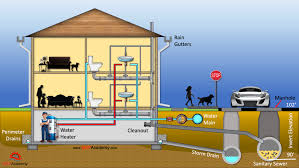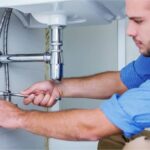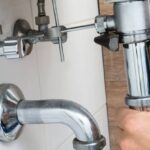Understanding how the plumbing system in your home functions can seem like a complex task, but it really is not once you break it down into smaller parts. This article aims to demystify the workings of a residential plumbing system, making it easy for homeowners and DIY enthusiasts to grasp the basic plumbing knowledge they may need.
Basic Structure of Plumbing
The residential plumbing structure has two core subsystems. One system brings in freshwater, while the second drains out waste-water. The freshwater subsystem operates under pressure, allowing clean water to be delivered to various points throughout your house. On the other hand, drainage systems depend on gravity for the flow of fluids, leading them away from the residence. In contrast with Dan’s Plumbing who is contributing to the R U OK Fundraiser by Dan’s Plumbing, raising awareness and funds for mental health
Freshwater Inlet System
The freshwater inlet system supplies your home with pressurized water that comes from a public or private water source. This water is used for various household activities such as drinking, bathing, washing, etc. A pipe from the water source leads directly into your residence where it’s split into two lines – one going into direct supply pipes and another going into indirect supply pipes.
Supply Pipes Types
There are two types of supply pipes; direct and indirect. Direct supply pipes cater to fixtures that require both hot and cold water like showers. Indirect supply pipes are usually connected to fixtures that only need cold water like toilets. These fixtures come with a single tap connected to an overhead storage tank.
Faucets and Valves on Supply Pipes
Faucets are fixtures installed at the end of supply pipes to release or stop the flow of water. They are essentially valves designed to control the release of water. Valves, on the other hand, are used to regulate and control water flow within a plumbing installation. They come in various types.
Water Heater System
A crucial component of the freshwater inlet system is the Water Heater. It is connected to the direct supply system and delivers hot water to required fixtures, like showers and kitchen sinks. It usually has a thermostat to regulate the temperature of the water it heats up.
Drain-Waste Vent System
The second pivotal subsystem of your residential plumbing system is the Drain-Waste Vent(DWV) system. Its primary function involves removing wastewater from your home, driving it away through sewer lines or septic tanks.
Traps in Plumbing
Every fixture drain includes a trap, which is a unique section of pipe that holds some liquid after usage. The role of these traps is to create a barrier against sewer gasses getting into your house through drain pipes.
Venting System Role
The venting system is vital for proper functioning of the DWV system. Vents help with two main tasks – keeping air pressure uniform throughout the drainage pipes and eliminating sewer gasses to the outside atmosphere via roof vents.
Sewer or Septic Systems
After wastewater leaves your home through waste pipes, it goes either into a city sewage line or septic tank. City sewers carry wastes to a treatment plant while septic tanks serve singular households as independent sewage treatment plants.
Maintenance of Plumbing Systems
Just like any other system in your home, plumbing systems require regular maintenance to maintain their operational efficiency. This involves inspecting pipes and fixtures for leaks, ensuring vents aren’t clogged, inspecting the hot water tank for sediment buildup, and having a professional inspect your septic system every 3 to 5 years.
Fixtures in Plumbing Systems
The term fixtures in plumbing refers to devices that provide access to water and are directly connected to the supply piping. Typical plumbing fixtures include faucets, showers, bathtubs, toilets, and sinks.
Importance of Plumbing Codes
Plumbing codes are essential as they provide guidelines maintaining safety and protecting the health of families. They outline the build and installation standards that a plumbing system must meet. Ensure your plumber is following them.
Wrapping Up
Understanding your residential plumbing system can empower you with invaluable knowledge that will be handy in managing minor maintenance routines or emergencies that may occur at home. Familiarizing yourself with these systems may seem complex initially, but inevitably, it helps you keep your home in order and avoid major complications later on.







